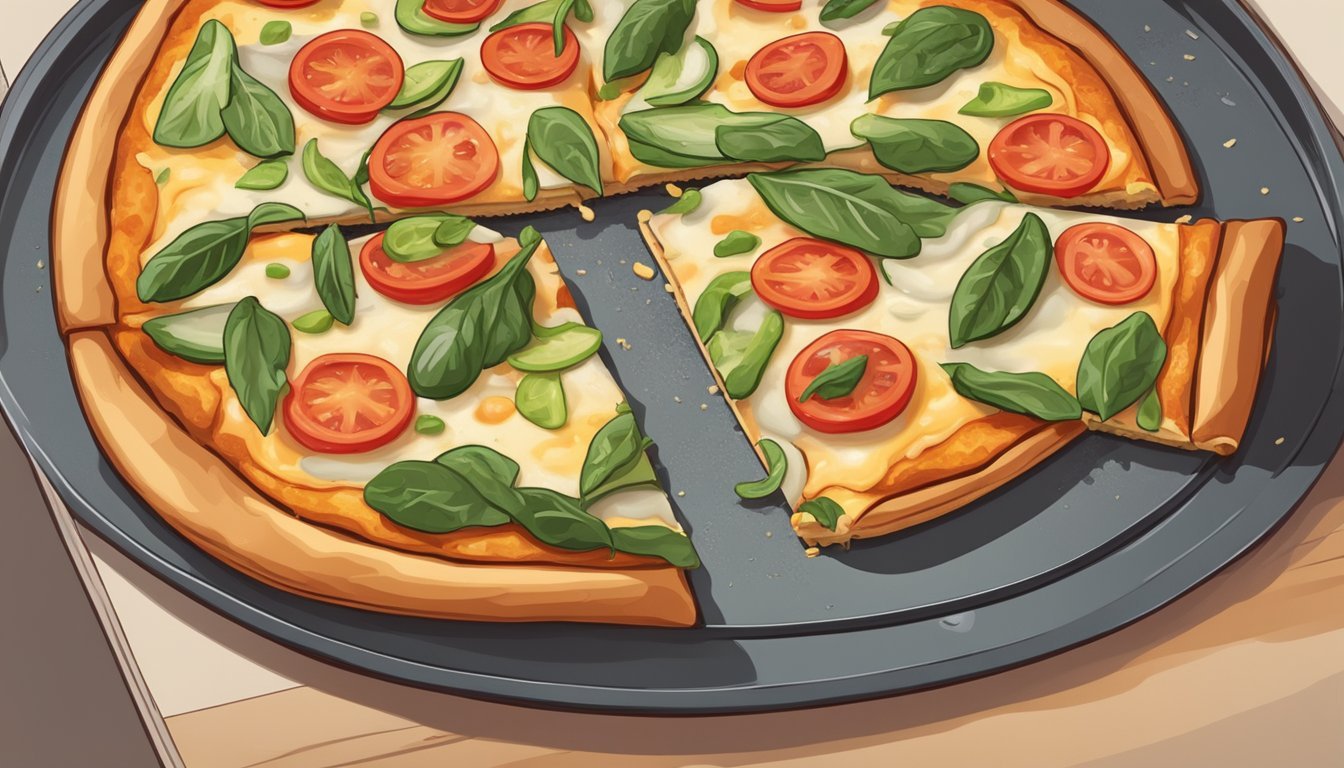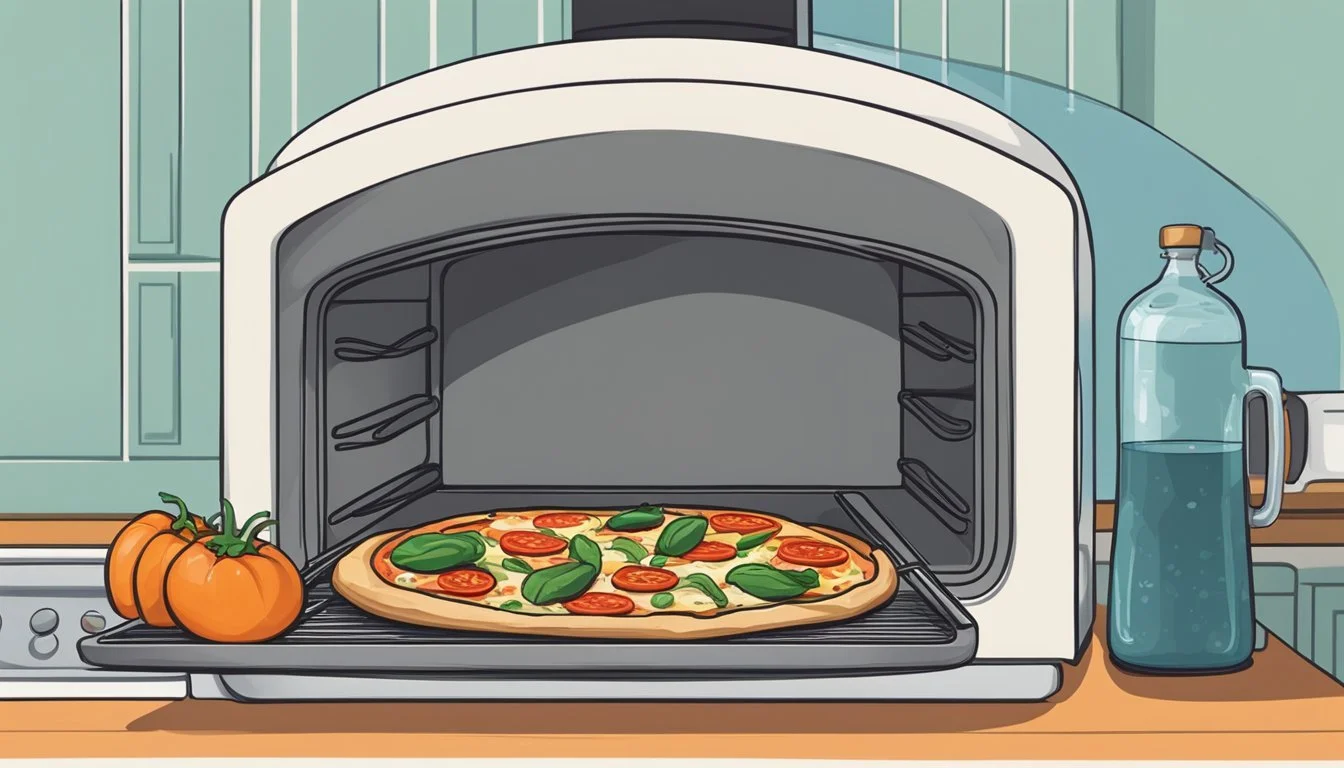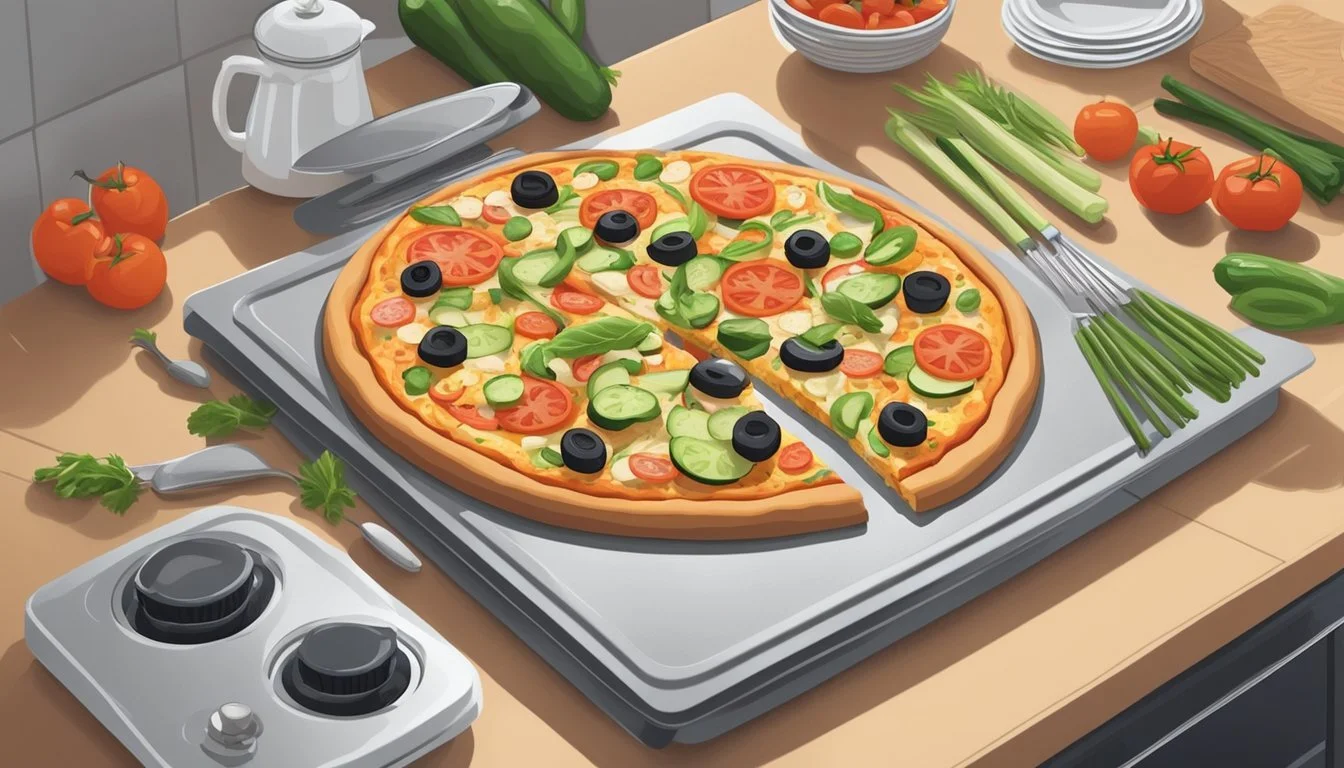Best Way to Reheat a Veggie Pizza
Ensuring a Crispy Crust Every Time
Reheating a veggie pizza to achieve a crispy crust can be a culinary challenge, yet it is essential to replicating the fresh-from-the-oven experience. To ensure the crust retains its crunch while the toppings warm through, it's important to use a method that applies heat evenly and avoids sogginess. Many pizza enthusiasts swear by the oven or toaster oven methods, which involve re-crisping the pizza at a moderate temperature on a preheated surface or directly on the rack.
Another effective approach is to employ a skillet on the stovetop, a technique that can revive the crispiness of the pizza's bottom while simultaneously melting the cheese through the use of a lid, which retains heat. The skillet method mimics a pizza oven's hot stone, drawing out moisture from the crust to restore its original crunchy texture. This method is particularly beneficial for veggie pizzas, where the water content in vegetables can make the crust soggy if not reheated correctly.
In contrast to these methods, microwave reheating is often a less preferred option as it can lead to a chewy and soft crust. However, a clever workaround involves placing a cup of water alongside the pizza during microwaving. This can help maintain a crispy crust by absorbing some of the microwave's energy and reducing the sogginess typically associated with this reheating method.
Understanding Pizza Reheating
Reheating pizza properly can affect both the taste and texture, especially for a veggie pizza where the crust's crispiness is paramount and the toppings' freshness is a concern. Maintaining the desirable qualities of the pizza when reheating is not always straightforward.
Fundamentals of Reheating Pizza
Key Considerations:
Temperature: Moderate to high heat enables the crust to become crisp without overcooking the toppings.
Method: Different reheating techniques can yield varying textures and levels of crispiness.
Time: Overheating can lead to drying out the pizza, while underheating may result in a soggy crust.
Effective Techniques:
Oven: Preheat to 350°F and bake the pizza on a piece of foil directly on the rack for 8-10 minutes.
Toaster Oven: Similar to the conventional oven but may require less time due to its smaller size.
Skillet: Medium heat until the base of the pizza is crisp can retain the moisture of the toppings.
Microwave with water: Using a mug of water nearby to introduce moisture prevents the crust from becoming too chewy.
Challenges of Reheating Leftover Pizza
Leftover pizza often loses moisture, which can result in a rubbery texture upon reheating. Veggie toppings are particularly delicate because they can either become overly dried out or release additional moisture, causing a soggy crust. Each reheating method needs careful consideration:
Oven: Risk of over-drying, particularly for vegetables that are prone to dehydration.
Microwave: Convenience is traded off with the potential for soggy crust and unevenly heated toppings.
Skillet: Offers more control over the crisping process but requires attention to avoid burning the crust.
Factors Contributing to Sogginess:
Excess moisture from vegetables
Not preheating the oven or skillet
Stacking slices on top of each other, which traps steam
Preparing to Reheat Your Pizza
To ensure your veggie pizza retains its flavor and crispiness, proper preparation is key. Using the correct storage methods and reheating tools can make a significant difference in the quality of your reheated pizza.
Preserving Your Pizza's Quality
Storing leftover pizza properly is crucial to maintain its texture and taste. One should use an airtight container or wrap the pizza slices in aluminum foil or plastic wrap to prevent them from drying out in the refrigerator. If pizza slices are piled on top of each other, placing a layer of parchment paper between them can prevent sticking and preserve the toppings' integrity.
Selecting the Right Tools for Reheating
When reheating pizza, choosing the appropriate method and tools is essential for keeping the crust crispy. Aluminum foil can be used if the pizza is reheated in an oven, as it aids in distributing heat evenly. Alternatively, using a preheated skillet can provide a crisp crust without the need for additional materials. For those opting to use a microwave, placing a cup of water alongside the pizza on a microwave-safe plate can help in keeping the crust from becoming too tough. However, it's important to note that a microwave might not yield as crispy a crust as an oven or skillet would.
Reheating Pizza in an Oven
When reheating veggie pizza in the oven, the objective is to refresh the taste and texture as if it's freshly baked. Achieving a crispy crust without overdoing the toppings requires particular attention to oven set-up and baking techniques.
Using a Conventional Oven
Reheating pizza in a conventional oven begins with preheating it to a high temperature. Preheating is important for two reasons: a uniformly hot environment will restore the crust's crispiness, and a quick reheat prevents the vegetables from becoming too soggy. Here's how to properly stage the oven for reheating pizza:
Temperature: Preheat the oven to 375°F (190°C).
Rack Position: Place the oven rack in the middle position to ensure even heat distribution.
Oven Baking Techniques for Crispy Crust
The method of placing the pizza in the oven significantly affects the quality of the reheated crust. To ensure that the crust regains its crispiness without burning, follow these steps:
Prepare the Baking Sheet:
Line a baking sheet with aluminum foil.
For extra crispness place the lined baking sheet in the oven during preheating.
Bake the Pizza:
Transfer the leftover veggie pizza onto the preheated baking sheet.
Place the pizza in the oven on the middle rack.
Bake for about 4-6 minutes or until the crust achieves the desired crispiness and the toppings are heated through.
These baking techniques, employing the consistent heat of an oven and using a preheated baking sheet or pan, help to revitalize the crust's texture while warming the toppings gently to preserve their flavor and integrity.
Alternative Reheating Methods
Reheating veggie pizza to achieve a crispy crust can be accomplished through various methods, each offering a unique texture and flavor. Below are several effective techniques for reviving your leftover pizza.
Stovetop Skillet Method
Using a skillet on the stovetop is an excellent way to reheat a slice of veggie pizza. For the skillet method:
Heat a nonstick or cast-iron pan over medium heat.
Place the pizza slice in the skillet without adding any additional oil.
Cook for about two minutes, then add a few drops of water to the pan, away from the pizza and cover it with a lid to steam the toppings without making the crust soggy.
Using an Air Fryer or Toaster Oven
The air fryer or toaster oven provide a quick and convenient reheating option:
For the air fryer:
Preheat it to 320-350 degrees Fahrenheit.
Heat the pizza for 3-5 minutes.
Check periodically to prevent overcooking.
For the toaster oven:
Preheat to 350 degrees Fahrenheit.
Bake the pizza for 5-10 minutes, until desired crispness is achieved.
Grill Method for Outdoor Flavor
One can utilize an outdoor grill for reheating pizza to add a smoky flavor:
Preheat the grill to a medium-low temperature.
Place the pizza directly on the grill grates.
Close the lid and grill for a few minutes until the crust is crispy and the toppings are heated through.
Microwave Reheating Techniques
For a quick method, the microwave can be used with a special technique to maintain moisture:
Microwave the slice on a plate alongside a cup of water.
Use high power for 30 to 60 seconds.
This method helps prevent the crust edges from hardening and keeps the pizza more evenly heated.
Perfecting Pizza Toppings and Cheese
A reheated veggie pizza should strive to preserve the texture and flavor of the cheese and toppings as if it were fresh out of the oven. Below are specific techniques to ensure that the cheese is hot and melty and the vegetable toppings maintain their integrity.
Ensuring Melty, Gooey Cheese
To achieve melty, gooey cheese, one must carefully monitor the heating temperature and duration. Cheese should reach a point where it is uniformly heated without becoming rubbery or oily. In an oven setting:
Temperature: Preheat to 375°F (190°C).
Time: Heat for about 5-7 minutes.
Check regularly to prevent overheating, as each oven's temperature calibration may vary. Melted cheese is best monitored visually; when it begins to bubble slightly, it typically indicates perfect meltiness without approaching the stage where oils begin to separate from the solids.
Maintaining Toppings Integrity
The key to preserving the toppings on a veggie pizza is to protect them from becoming soggy while reheating. Vegetables should retain their crispness and flavor. Recommendations include:
Protection: Cover the pizza with foil loosely to shield the vegetables from direct heat.
Layering: If the pizza was originally baked with specific topping layers, ensure they remain in the same order for balanced reheating.
Toppings like onion and cherry tomatoes should exhibit a slight shrug, signaling they are warmed thoroughly without overcooking. Equally, if the pizza features tomato sauce, it should remain saucy and not dry out. Keeping this balance is crucial for a satisfying reheated veggie pizza experience.
Additional Tips and Tricks
To ensure a crispy crust and enhance the flavor of leftover veggie pizza, one must avoid common reheating mistakes and apply specific techniques that can turn a soggy slice into a delectable treat.
Avoiding Common Mistakes
When reheating pizza, people often opt for convenience over quality, leading to common errors like microwaving or overcrowding the slices. A microwave can make the crust chewy, so it should be used sparingly and with a cup of water to retain moisture within the dough. To maintain crispiness, reheat only a few slices at a time on a baking tray or in a frying pan to prevent steam from softening the crust.
Microwave Mistake: Only use as a last resort; place a cup of water inside to avoid a chewy crust.
Overcrowding: Limit the number of slices on any reheating surface to prevent steam buildup.
Enhancing Leftover Pizza Flavor
Leftover veggie pizza can taste as good as freshly made with the right technique. Reheating in a frying pan brings back crispness to the crust. For added flavor, consider spritzing olive oil on the crust edges before reheating or adding fresh herbs (how long do fresh herbs last?) like basil after cooking. This not only revives the pizza but can elevate the overall taste, turning a simple leftover slice into a homemade pizza experience.
Olive Oil Spritz: Lightly coat the crust edges before reheating to enhance flavor.
Fresh Herbs: Sprinkle basil or oregano after reheating to give the taste of a homemade pizza.
Safety and Cleanliness
When reheating veggie pizza, one must ensure safe handling to avoid contamination and maintain cleanliness of equipment to prevent buildup of residue.
Handling and Consumption Safety
Proper safety during handling and consumption is critical. One should always wash their hands before and after dealing with food to prevent the spread of germs. Moreover, the reheated pizza must reach a safe internal temperature, generally above 165°F, to be considered safe for consumption. It's important to avoid cross-contamination; for instance, never reheat your pizza on surfaces that had raw food on them without cleaning them first.
Avoid using plastic bags or materials that can melt or cause harmful chemicals to leach into the pizza when reheated.
Keep oil and greasy items away from direct contact with the oven or other heating element to prevent fire hazards.
Cleanup and Maintenance of Equipment
Efficient cleanup and maintenance of equipment after use is essential not only for hygiene but also to extend the longevity of your kitchen tools. For example, when using a pan to reheat pizza, one should:
Once cooled, wipe off any greasy residues with a paper towel before washing with soapy water.
After using an oven, check for and remove any fallen toppings or cheese to prevent burning and smoke in subsequent uses.
When cleaning appliances:
Make sure they have cooled down completely before attempting to clean.
Use appropriate cleaning agents and tools that are safe for the specific equipment materials.
If water is used in the process, such as steaming inside a pan to melt cheese, make sure the appliance is dry before its next use to avoid rust or electrical issues.
Conclusion
In seeking the optimum method to reheat a veggie pizza, the focus lies on preserving the crispiness of the crust and the freshness of the toppings. The use of a skillet, oven, and even a microwave with a mug of water have been identified as effective reheating methods. Each technique serves to balance the crispness of the crust with the need to maintain the integrity of the vegetable toppings.
To summarize, here are the reheating methods to consider:
Skillet: Heat the pizza over low heat, covering it with a lid to melt the cheese and avoid drying out the vegetables.
Oven: Preheat to 350 F and use a preheated sheet pan or place the pizza directly on the rack.
Microwave+Water: This approach can moisten the cheese while preventing the crust from getting too soft.
It becomes evident that reheating pizza requires gentle heat and, occasionally, the introduction of moisture to restore the balance achieved when the pizza was first baked. Connoisseurs might advocate for the skillet method, praising its ability to deliver evenly melted cheese and a satisfyingly crisp crust without compromising the vegetables.
Ultimately, the best reheating technique will rely on personal preference and the specific characteristics of the pizza in question. Those seeking convenience may opt for the microwave, while purists might lean towards the oven or skillet for a result that closely mirrors the texture and flavor of freshly baked pizza.






